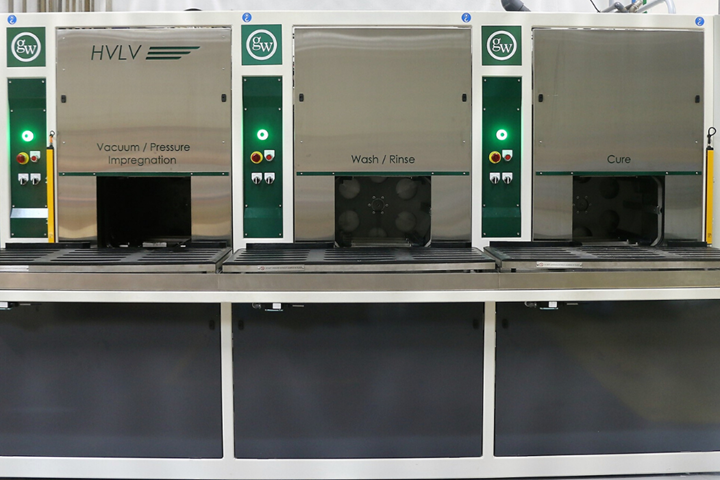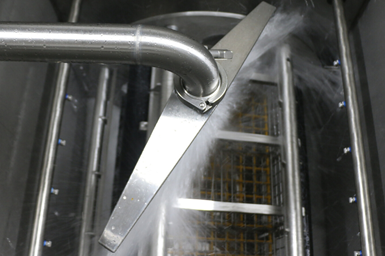
When Anoplate wanted to improve production flow and efficiency, they implemented a high value low volume vacuum impregnation system from Godfrey & Wing. All photos from Godfrey & Wing
An effective production flow requires workstations and equipment to be arranged in a sequence that supports a smooth flow of parts and materials with minimal delays. Implementing an efficient production flow leads to increased production and flexibility, as well as a reduction in capital requirements.
Anoplate (Syracuse, N.Y.), an industrial surface engineering company serving a broad base of industries, faced a production flow dilemma. The company offers vacuum impregnation services to seal leak paths and eliminate failure modes that could develop from outgassing, chemical incompatibility or bleed out of pretreatments in porous materials. Anoplate processes high value, complex die castings for some of the largest and most respected aerospace, defense, information technology and recreation companies in the world. The castings often have thin walls with small blind taps.
Featured Content
The challenge
Anoplate’s operations span across two buildings. Its headquarters include its offices and vacuum impregnation operation. The second building, located across the street, houses its vapor degreasing and plating operations. Anoplate uses in-house batch impregnation systems to process the die castings. The batch system aggregates various parts and processes them in large batches. Before impregnation, parts are processed through vapor degreasing.
Despite being well versed in vacuum impregnation, the company could not efficiently process complex castings due to three limitations of their batch systems:
- Contamination: Extra steps were needed to get clean, sealed parts. Cured sealant and oil remained in through and blind tape holes, requiring the operator to hand wash machine and tap holes after the process. Also, many parts required double impregnation.
- Sealant usage: The system processing baskets were the cause of high sealant dragout. This dragout led to high sealant use and increased material costs.
- Ineffective production flow: The process routing (degrease, impregnate, plate and finish) had parts traveling between facilities multiple times, constantly placed in and out of transport dunnage. The amount of handling increased the risk of damage, reduced the control of inventory and increased the cost of processing.
The solution
The company laid out its vision, and Godfrey & Wing (Aurora, Ohio) responded with the lean, front-loading High Value Low Volume (HVLV) vacuum impregnation system, customized to address the company's challenges.

The HVLV was able to seal leak paths, eliminate contamination and reduce sealant usage.
To eliminate contamination, Godfrey & Wing designed custom fixtures to maximize the number of castings per cycle and protect critical machined features. The HVLV's advanced wash cycle was programmed with an aggressive wash to flush sealant from blind holes and machine features.
With this system, the parts would then be centrifuged after impregnation to recover unused sealant. The sealant would be returned to the sealant reservoir for use in subsequent cycles. The HVLV would recover unused sealant before the wash, eliminating sealant drag out and risk of contamination.
Recognizing the company's desire to place the system in the same building as plating, Godfrey & Wing designed the HVLV to align with production. HVLV's modular footprint requires 96 square feet without any floor changes. Godfrey & Wing also studied how the HVLV would integrate with Anoplate’s order of operations and concluded that, with the HVLV, Anoplate's vapor degreasing process could be eliminated.

To eliminate contamination, Godfrey & Wing designed custom fixtures to maximize the number of castings per cycle and protect critical machined features.
While the system sounded perfect, Anoplate conducted rigorous sample testing before investing. Samples were processed at Godfrey & Wing's headquarters on a machine identical to the HVLV proposed to Anoplate. The results demonstrated that the HVLV not only sealed the leak paths, but eliminated contamination and reduced sealant usage. Also, the company was able to see firsthand how the modular footprint could easily fit into its existing production line. With these results, Anoplate purchased an HVLV.
The results
The HVLV was installed, operators and maintenance technicians were trained and the system was processing parts in under two weeks. Since then, the HVLV is addressing Anoplate's key challenges. The new system:
- Eliminates contamination. The system’s custom fixtures and thorough wash are processing all parts successfully and without any trace of residual sealant contamination.
- Minimized sealant usage. Sealant dragout has been greatly reduced, and sealant costs have gone down by 50%.
- Improved production flow. The HVLV operates alongside the plating operations. By delivering parts directly to the impregnation system, labor costs have been reduced by 50% and production throughput has increased by 30%.
“Considering our challenges, the HVLV has been a very effective solution delivering unrivaled quality for our advanced manufacturing environment,” says Jesse Campbell, Anoplate's vice president of engineering. “This system has also changed our perception of vacuum impregnation equipment in that it is simple to use, and the look is sleek and modern.”
In summary, the HVLV created a competitive advantage for Anoplate's vacuum impregnation services. The system has transformed its impregnation business by reducing costs, increasing quality and improving efficiency.
RELATED CONTENT
-
Cleaning, Pretreatment to Meet Medical Specs ISO 13485 or FDA 21 CFR820
Maximilian Kessler from SurTec explains new practices for industrial parts cleaning, metal pretreatment and decorative electroplating in the medical device industry.
-
Masking for Surface Finishing
Masking is employed in most any metal finishing operation where only a specifically defined area of the surface of a part must be exposed to a process. Conversely, masking may be employed on a surface where treatment is either not required or must be avoided. This article covers the many aspects of masking for metal finishing, including applications, methods and the various types of masking employed.
-
Plating Q&A: Can you color stainless steel?
Our expert, Art Kushner, says yes, you can color stainless steel, but it is not a process that is typically performed in a plating shop. Read more about his answer.



















